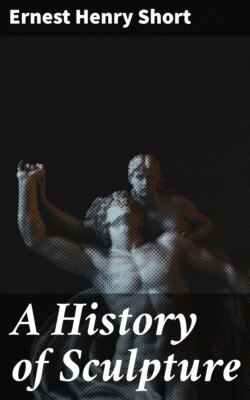Читать книгу A History of Sculpture - Ernest Henry Short - Страница 6
На сайте Литреса книга снята с продажи.
CHAPTER I
ОглавлениеTable of Contents
THE RISE OF GREEK SCULPTURE AND THE
ATHLETIC SCULPTURES OF GREECE
Nowadays sculpture is not an acknowledged queen in the Tourney of the Arts. The writer who has thrust her colours into his casque and would break a lance on her behalf, struggles for some unstoried damsel about whose very existence he has been playfully twitted by the champions of the reigning beauties.
Rightly considered, art is but a form of speech—sculpture speaking through words formed from chiselled marble and moulded bronze. Such a language can only have lost its meaning if the men of to-day differ fundamentally from those of the past. But is this the case? Can any one doubt that human thought and action are ever substantially repeating themselves, since men and women are at all times actuated by substantially the same passions? The twentieth century simply requires to realise that sculpture throbs with the thought and emotion astir in itself. Though it cannot be claimed that the art is popular in the sense that music and painting are popular, our firm conviction is that its peculiar thrill only needs to be felt, for sculpture to become as widely appreciated as the sister arts. Dancing may be a lost art; we are assured sculpture is not.
Under these circumstances, honesty compels us to preface this book with a confession. It is a history of sculpture with a purpose. It seeks to entice a few men and women into the belief that sculpture is, essentially, a living art. Its one object is to marshal the evidence in favour of the proposition that the marbles and bronzes of the great sculptors are not dead things which may well be left to gather dust in national museums and unfrequented corners of public galleries.
Though marble and bronze have not lost their potency, it would be folly to regard all sculpture as equally vital. Much has only an archæological or antiquarian interest in these latter days. Consequently, though building from the bricks of the past, everything which has lost its meaning for the men of to-day will be ruthlessly excluded. Our purpose is to write a history of the art itself, to show how its various manifestations arose from social and political circumstances, to trace the emotions and thoughts which stimulated the artists to produce their greatest works and to gauge the action and interaction which created the various national styles. On the one hand is the sculptor expressing what appears to be his own thoughts and emotions. On the other, the men of his country and time providing him with the raw material of thought and feeling, and compelling the production of works which could never have seen the light had he dwelt on a column in the desert after the manner of some Alexandrian mystic. Nor is this all. In addition, there is the influence which the sculptor exerts upon those around him, and particularly upon his fellow craftsmen. Out of the reciprocal modification arises a body of sculptural production, endowed with a definite national style.
The task of estimating these actions and counteractions and their effects cannot be an easy one. It calls for heart as well as mind, both from writer and reader. It would be fatal to treat the bronzes of Polyclitus, the marbles of Phidias, Donatello, and Michael Angelo, as too many historians do the documents from which they presume to create the past. Even if political history can be profitably reduced to a dull catalogue of charters and enactments—which we deny—the history of an art cannot. That must take human passion and emotion into account, and must be written by those who are not afraid to feel or ashamed of their feelings. From any other standpoint, art becomes divorced from life. The reader is denied a glimpse of its most potent force—its mysterious power of arousing echoes in his own heart.
Fortunately, the ground to be covered is pregnant with interest. The story of the meteoric rise of the art in Greece, so sudden that a paltry half-century separated the dead work of the sixth century from the vitalised marbles of the Parthenon, will be followed by an account of the “Golden Age,” in which sculpture expressed the whole nature—physical, mental, and spiritual—of the most complete men who have ever lived. Thence to the art of the Alexandrian and Roman Empires, leading up to the great revival of sculpture in the city states of Northern Italy. Finally, a consideration of the sculpture of Monarchical, Imperial, and Republican France will lead up to the works of our own time and the final problem—how near such a sculptor as Rodin is to assimilating and expressing the strange and wonderful experiences arising from the stress of modern life.
In the nature of things all our correlations will not be equally exhaustive or correct. The philosophical method is more open to errors arising from individual prejudice than the more strictly scientific one, which is content to collect and group examples. In some cases, moreover, peculiarities of style and subject will depend upon circumstances extremely remote from present-day experience, and, therefore, peculiarly difficult to express adequately. Nevertheless, we hope to suggest a method, and to lay a foundation upon which our readers will be able to build. Though we shall base our generalisations upon a comparatively few examples, we shall seek to provide niches into which practically all the greater works of sculpture can be fitted.
